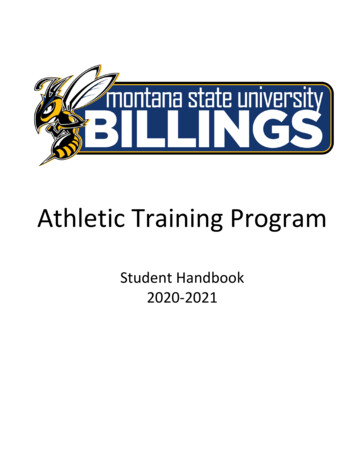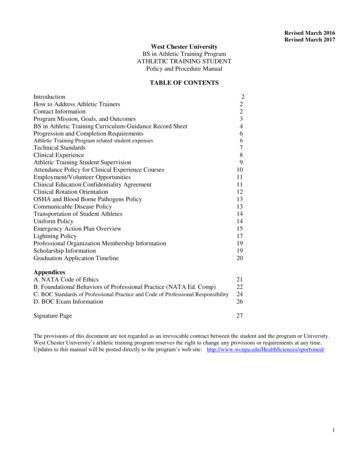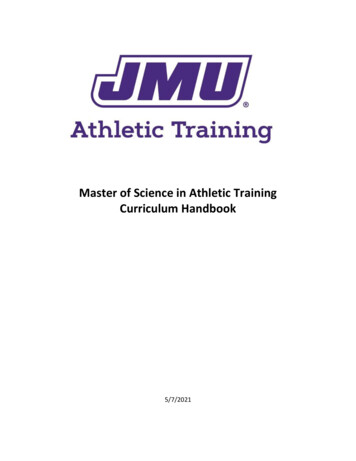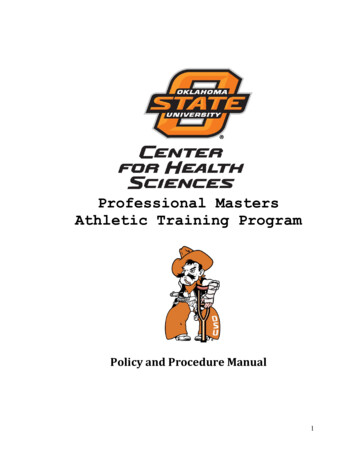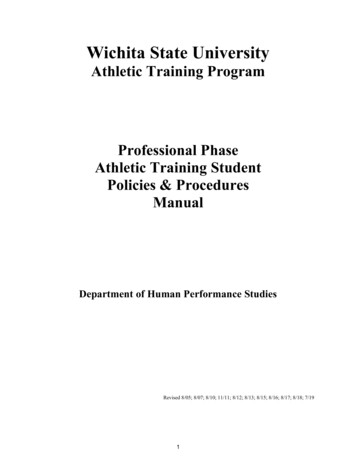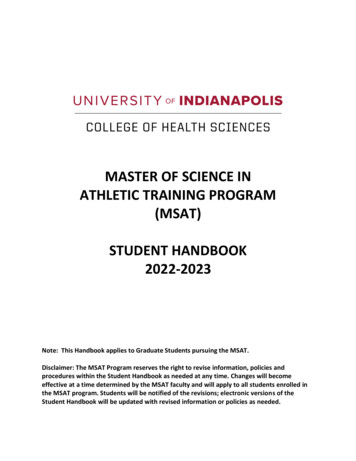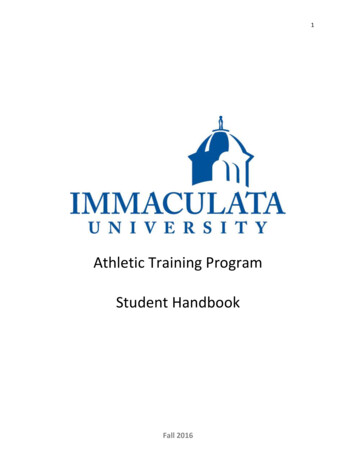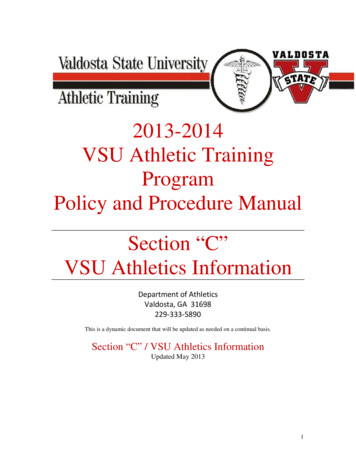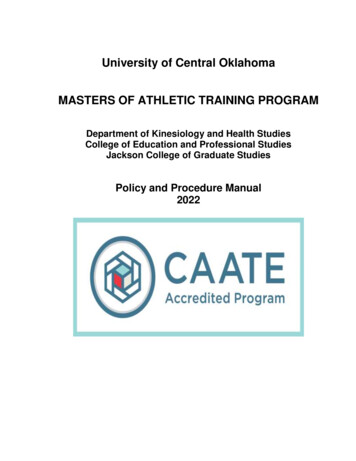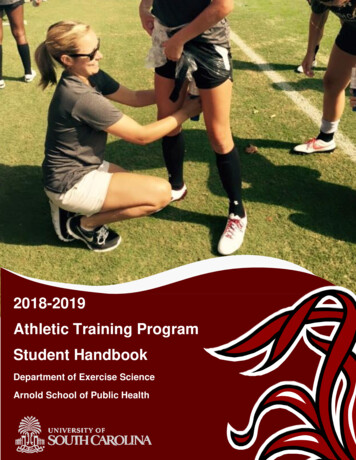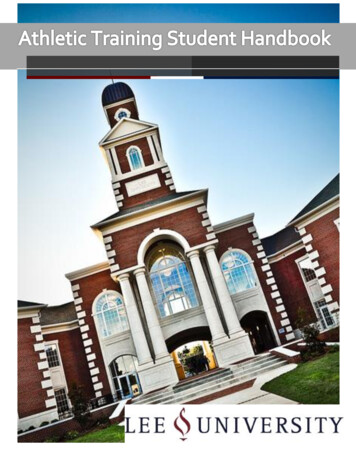
Transcription
232018-2019i
Table of ContentsSECTION 1: IntroductionIntroduction . 2Mission Statements . 3Program Goals and Objectives . 4Program Overview . 12Professional Relationships . 13Social media Policy . 13Program Policies and ProceduresCompetitive Admissions Policy . 15Fees for the Program . 16Retention, Continuation, Withdrawal, and Completion . 17Disciplinary Policy . 19Grievance Policy . 20Off-Campus Clinical Experiences . 20Verification of Clinical Hours . 21Transfer Policy . 21Student Conduct . 21Standard of Dress . 22Personal Cellular Telephones . 23Student Health Policy. 24Student Non-Discrimination Policy . 25SECTION 2: Clinical Education in the Athletic Training ProgramClinical Education Plan . 27Clinical Education Guidelines. 30CPR Verification Guidelines. 33OSHA Guidelines . 33Additional References . 36APPENDICESA. Academic Administration Structure & Personnel Directory . 37B. NATA Code of Ethics . 38C. MSAT Courses & Course Sequence . 40D. Standards for the Accreditation (CAATE). 41E. Application for Admission into the MSAT .58F. Fingerprinting & Background Check . . .59G. Student Athletic Trainer Confidentiality Agreement . 60H. Technical Standards for Admission . 61I. Policy and Procedure Agreement Form . 64J. Immunization Forms or Waiver . 65K. Primary, Affiliated, and Allied Site Policy and Procedures. 68ii
iii
The Athletic Training Education Program@ Lee UniversityINTRODUCTION1
Lee UniversityAthletic Training Education ProgramINTRODUCTIONAthletic training is recognized by the American Medical Association as an allied health carefield. A Certified Athletic Trainer (ATC) is an educated and skilled professional that meetsthe entry-level educational competencies, clinical proficiencies, and clinically integratedproficiencies established by the Commission on Accreditation of Athletic Training Education(CAATE) and successfully complete the Board of Certification (BOC) examination.An athletic trainer is knowledgeable and skilled in the following areas:1. Evidence-based practice2. Prevention and health promotion3. Clinical examination and diagnosis4. Acute care of injuries and illnesses5. Therapeutic interventions6. Psychosocial strategies and referral7. Healthcare administration8. Professional development and responsibilityTo be eligible to become an ATC, one must complete a Master of Science in athletic trainingprogram (MSAT) from a CAATE approved program and graduate from an accredited collegeor university in the United States. Completing the MSAT ensures that a student will haveaddressed all educational competencies and clinical proficiencies established by the CAATE,will possess the entry level knowledge and skills of a certified athletic trainer, and will beeligible to take the BOC examination.Certified athletic trainers practice in a variety of settings and roles. The traditional setting,where many athletic trainers are employed, is the athletic training room within aninterscholastic or intercollegiate athletic program. Other sites include professional sports,hospitals, fitness and wellness centers in an industrial setting, physical therapy facilities,sports medicine clinics, and others.The athletic training room provides a unique learning environment for athletic trainingstudents: They can apply knowledge, acquire new skills, and practice these skills under theguidance of a certified athletic trainer. Under the supervision of certified athletic trainers,students of the athletic training program have the opportunity to gain “hands on” experiencethrough the care of athletes and the physically active. The athletic training room will providea means to integrate academic knowledge with clinical practice.Weekly meetings, daily proficiency practice and evaluation, and continual written and verbalfeedback provide a way to facilitate the integration of academic knowledge and clinical skills.While student feedback is important for student growth, the student’s ability to communicate(written and verbally) will develop through peer teaching and clinical documentation. Thiscompetency-based program has been developed to guide students through their educationalexperience, enhance the learning environment, provide faculty and staff athletic trainers withan assessment tool, and optimize the quality of care provided to the physically activepopulation.2
MISSION STATEMENTSThe NATAThe mission of the National Athletic Trainers' Association (NATA) is to enhance the qualityof health care provided by certified athletic trainers and to advance the athletic trainingprofession. Retrieved from https://www.nata.org/about on April 10, 2019.Lee UniversityLee University is a Christian institution which offers liberal arts and professional education onboth the baccalaureate and graduate levels through residential and distance programs. It seeksto provide education that integrates biblical truth as revealed in the Holy Scriptures with truthdiscovered through the study of arts and sciences and in the practice of various professions. Apersonal commitment to Jesus Christ as Savior is the controlling perspective from which theeducational enterprise is carried out. The foundational purpose of all educational programs isto develop within the students’ knowledge, appreciation, understanding, ability and skillswhich will prepare them for responsible Christian living in a complex world.Athletic Training Education ProgramThe Lee University Athletic Training Education Program serves as integral part of theDepartment of Health, Exercise Science, and Secondary Education (HESSE) under thedirection of the College of Education (See Appendix A), Academic AdministrativeStructure/Personnel Directory. The function of the program shall be to enhance health carefor the habitually active community of the university. The program will service the collegecommunity by endeavoring to help its members attain higher levels of performance throughproper health care and appropriate injury/illness preventive measures.The program’s educational philosophy encompasses current research and formal instructionin healthcare screening, design and implementation of research, prevention of injury andillness, recognition and evaluation, and therapeutic interventions of conditions and injuriessustained by various populations to include healthcare that accounts for social, economic,and health disparities. From a Christian framework of empathy, compassion, and serviceto others, the students will be taught educational standards in knowledge, skill, andappropriate professional behaviors. A MSAT student will have the opportunity to develop3
applied technical and clinical skills incorporating analytical problem-solving abilities to assistwith the daily operation of traditional and non-traditional athletic training settings.It is an aim of the program to produce a corps of athletic training students that shall advancethe profession of athletic training at a local and national level through utilization of superiorevidence-based practice. The vision of our professional Masters of Athletic Training is todevelop the students’ knowledge, appreciation, understanding, and clinical reasoning whichwill prepare them for responsible Christian living in a complex world as a health care provider.The program mission is to teach students three core values, which include; (1) knowledge andskill competency, (2) critical and integrative thinking and (3) personal, professional, andethical behaviors of a practitioner.Foundational knowledge and competent clinical skills that prepare alliedhealth care workers to function in a complex worldCritical appraisal of evidence based practice that will impact the quality ofpatient care through connecting integrative thoughtsIndividual skills and attitudes of a life-long learner which representprofessional responsibility to society and self in regard to both legal andethical issuesCritical &IntegrativeThinkingPersonal,Professional& EthicalPractitionerKnowledge& SkillCompetency4
Foundational Behaviors of Professional PracticeThese basic behaviors permeate every aspect of professional practice and should beincorporated into instruction in every part of the educational program. The behaviors in thissection comprise the application of the common values of the athletic training profession asstated in the Athletic Training Educational Competencies.Primacy of the Patient Recognize sources of conflict of interest that can impact the client’s/patient’s health. Know and apply the commonly accepted standards for patient confidentiality. Provide the best health care available for the client/patient. Advocate for the needs of the client/patientTeam Approach to Practice Recognize the unique skills and abilities of other healthcare professionals. Understand the scope of practice of other healthcare professionals. Execute duties within the identified scope of practice for athletic trainers. Include the patient (and family, where appropriate) in the decision-making process. Work with others in effecting positive patient outcomes.Legal Practice Practice athletic training in a legally competent manner. Identify and conform to the laws that govern athletic training. Understand the consequences of violating the laws that govern athletic training.Ethical Practice Comply with the NATA’s Code of Ethics (See Appendix B) Understand the consequences of violating the NATA’s Code of Ethics. Comply with other codes of ethics specific to Lee University, as applicable.Advancing Knowledge Critically examine the body of knowledge in athletic training and related fields. Use evidence-based practice as a foundation for the delivery of care. Appreciate the connection between continuing education and the improvement of athletictraining practice. Promote the value of research and scholarship in athletic training. Disseminate new knowledge in athletic training to fellow athletic trainers, clients/patients,other healthcare professionals, and others as necessary.Cultural Competence Demonstrate awareness of the impact that clients’/patients’ cultural differences have ontheir attitudes and behaviors toward healthcare. Demonstrate knowledge, attitudes, behaviors, and skills necessary to achieve optimalhealth outcomes for diverse patient populations. Work respectfully and effectively with diverse populations and in a diverse workenvironment.Professionalism Advocate for the profession. Demonstrate honesty and integrity.5
Exhibit compassion and empathy.Demonstrate effective interpersonal communication skills.SummaryThe MSAT program is designed in a way where students can enter either in a January or Junecohort and progress appropriately through their clinical and didactic courses. Course sequenceis developed to fit with Lee University and HESSE departmental requirements to provide asoundly structured educational experience (See Appendix C). The program strives toincorporate the competencies and proficiencies in both the didactic and clinical experiences ofthe student. The faculty and clinical staff of the program make every effort to meet thefollowing goals, outcomes, and student learning objectives:6
Program Goal - Knowledge Competency: Foundational knowledge and competent clinical skills that prepareallied health care workers to function in a complex worldProgram Learning Outcomes1. The curriculum will producestudents with exceptional oral andwritten communication skills.Student Learning ObjectivesObjective AssessmentWhenThroughoutprogramAssessmentClinical evaluations, mocksimulations, presentationof researchSummer 1,Fall 1CourseATEP 500,501, 502,503, 504,530, 535ATEP 530,535, 540,541, 542ATEP 500,510, 5012.2Summer 1,Fall 1ATEP 510,501Project, written tests3.1Summer 1,Spring 1, Fall2, Spring 2Fall 1, Spring1, Fall 2,Spring 2Fall 1, Spring1, Fall 2ATEP 520,502, 504590ATEP 530,503, 535,504ATEP 501,502, 503Simulations, oral tests4.1Summer 1,Fall 1Simulations, skill checks,written tests4.2Summer 1,Fall 1Summer 1,Fall 1, Fall 2ATEP 520,ATEP 500,501ATEP 520,500, 501ATEP 520,ATEP 501,ATEP 5601.1 Students will acquire oral communication through peerteaching, clinical documentation, and professional interactions.1.2 Students will cultivate professional, scientific writing skillsthrough literature reviews, professional poster development,and research studies.1.11.2Fall 1, Fall 2,Spring 22. The curriculum will provideeducational training in riskmanagement, health promotions,and injury prevention technique.(CAATE: PHP).2.1 Students will demonstrate appropriate documentation,and skills through live and mock situations that prevents riskand injury in an active population.2.2 Students will design an exercise and nutritional plan forother students needing guidance in healthy living.2.13. The curriculum will provideknowledge of clinical examinationand diagnosis with an emphasis inpathophysiology of injuries andillness. (CAATE: CE).3.1 Students will demonstrate accurate and efficient diagnosticabilities and understanding of pathophysiology through clinicaland scenario based situations of disabilities and general medicalconditions.3.2 Students will demonstrate accurate and efficient diagnosticabilities and understanding of pathophysiology through clinicaland scenario based situations of orthopedic conditions.3.3 Students will demonstrate inter-professional collaborationduring clinical evaluations which enhances overall health of thepopulation.4.1 Students will demonstrate clinical effectiveness inresponding to emergency situations through the treatment ofacute illnesses and injuries.4.2 Students will recognize key emergency signs and symptomsin order to evaluate, compare, and differentiate appropriatepathologies.4.3 Students will develop an EAP explaining how to care foracute life-threatening signs and symptoms.4. The curriculum will provideknowledge of acute care of injuriesand illness of the habitually activethroughout different ages (CAATE:AC).3.23.34.3Case reports, writtenthesis & presentation ofresearchClinical simulationsSimulations, Writtenexams, ClinicalevaluationsNursing dept masscasualty simulation,health clinical evalOral & written tests, CIP 6Projects, simulations8
5. The curriculum provides excellentcommunity-centered service andinstruction in the knowledge ofhealth care administration (CAATE:HA).5.1 Students will develop policy and examples that effectively5.1demonstrates an understanding of the different facets ofhealthcare administration (e.g insurance, policies, EAP's,budget, etc.)5.25.2 Students will develop a budgetary needs assessment andfollow up RFQ for either high school, college, or a private ownedfacility.Summer 1,Fall 1, Fall 2,Spring 2ATEP 510,501, 560,504Projects, written testsFall 2ATEP 560Written tests, projectsProgram Goal - Critical and Integrative Thinking: Critical appraisal of evidence based practice that will impact thequality of patient care through analysis and synthesis of content and clinical experienceProgram Learning OutcomesStudent Learning ObjectivesObjective AssessmentWhenCourseAssessmentFall 2, Spring2Fall 1, Spring1, Fall 2,Spring 2Fall 1, Spring1, Fall 2,Spring 2ATEP 570,575ATEP 530,535, 503,504ATEP 530,353, 540,570, 575Projects, writtenexaminations, CIP 4Clinical evaluations, CIP 4&57.2Spring 1, Fall2, Spring 2ATEP 550,570, 575Written tests, oral tests7.3Fall 2, Spring2ATEP 590,504Written tests, CIP 5Nursing dept masscasualty simulation,health clinical evalSimulations, CIP 7 & 86. The program provides multipleclinically integrated proficiencyscenarios and projects thatdemonstrate critical and integratedthinking.7. The program establishes thatstudents will make variousrecommendations on patient care(or mock patient care) which reflecttheir level of expertise in selectingappropriate treatment and referralpost injury (e.g. pharmacological,nutritional, exercise, modalities,manual therapy, and non-traditionaloptions) (CAATE: TI).6.1 Students will develop care plans relative to patients’physical, mental, and emotional needs.6.2 Students will demonstrate emerging expertise (nonanalytical) of diagnostic reasoning ability.6.17.1 Students will utilize evidence based research to producecase studies and rehabilitation plans for injured patients.7.2 Students will select most appropriate tool to providepatient care which is at their disposal based on equipmentavailability.7.3 Students will develop a medication dispensing proceduresbased on pharmacological laws of distribution and packaging.7.4 Students will demonstrate specialized skill sets whileencountering inter-professional collaboration during treatmentdecisions which enhances overall health of the population.7.17.4Fall 1, Spring1, Fall 2ATEP 501,502, 5038. The curriculum affords multiplestudent learning encounters or mockscenarios which adequately prepare8.1 Students will make recommendations on patient care (ormock patient care) which reflects students’ level of expertise in8.1Fall 2, Spring2ATEP 570,575, 503,5046.2Research projects &presentations, writtenexaminations9
students to handle psychosocialinterventions (CAATE: PS).selecting appropriate treatment and referral for psychosocialissues.8.2 Students will recognize various emergency psychologicalconditions based on presented signs and symptoms.8.2Fall 2, Spring2ATEP 570,575, 503Written tests, CIP 8Program Goal - Personal, Professional & Ethical Practitioner: Individual skills and attitudes of a life-long learnerwhich represent professional responsibility to society and self in regard to both legal and ethical issuesObjective AssessmentProgram LearningOutcomesStudent Learning Objectives9. The program provides anopportunity for students to producecollaborative research with facultyand preceptors; and/or design anindividual research proposal whichwill enhance their success ingraduate school (CAATE: EBP).9.1 Students will incorporate patient-centered outcomemeasures to evaluate the quality of care provided.9.2 Students will produce collaborative research with facultyand/or design an individual research proposal which willenhance their ability to critically think.9.3 Students will produce quality patient care based onresearching best evidence available at any particular time.9.1Throughoutprogram9.2Fall1, Spring1, Fall2,Spring 2Spring 1, Fall2, Spring 210. The program advances theprofession of athletic training bytraining students to utilize EBPresearch to disseminate informationthrough workshops, websites, clubs,lecture(s), brochure(s), and/orsymposium(s)(CAATE: PD).10.1 Students will attend and present at educationalsymposiums to enhance professional growth and promoteBOC success.10.2 Students will demonstrate professional and competentlectures frequently across campus and in the community.10.3 Students’ professionalism will develop as they meetprogram benchmarks each year.10.111. The curriculum is designed toproduce students with anexceptional awareness of culturaldiversity and a cross culturalexperience that deepens thestudents’ philosophical appreciationof caring for others across theworld.11.1 Students will exhibit cultural awareness behaviors andwork respectively with diverse populations.11.2 Students will encounter volunteerism and cross culturalexperiences that will enhance their professional and personalgrowth.11.3 Students will develop a sense of servant leadershipthrough the integration of faith and practice.WhenCourseAssessmentATEP 500,501, 502,503, 504,540ATEP 530,535, 540,541, 542ATEP 550,570, 575,503, 504Clinical Evaluations,Written sional Presentations10.2Fall 2ATEP 565Community presentation10.3ThroughoutprogramCommunity based clinicalevaluations11.1Throughoutprogram11.2Summer 1,Fall 1, Fall 2,Spring 1ThroughoutprogramATEP 501,502, 503,504ATEP 500,501, 502,503, 504ATEP 500,501, 503,520ATEP 500,501, 502,503, 5049.311.3Thesis & presentationWritten tests, Researchproject & presentation,Clinical evaluationsClinical evaluationsNursing dept mass casualtysimulation, volunteerexperiencesClinical evaluations, exitinterviews, reflectivejournals10
12. The program provides trainingand application of the NATAfoundational behaviors and skills ofbeing an ethical and legalpractitioner of athletic training(CAATE: PD).12.1 Students will exhibit behaviors and encounter faculty thatare ethical, legal and competent.12.2 Students will develop mentorship with faculty,preceptors, and peers in order to foster a professional code ofconduct that reflects Christian commitment.12.3 Upon graduation, the students will pursue employmentand/or further education in a desired allied healthcare setting.12.1Throughoutprogram12.2Fall 1, Fall2,Fall 2, Spring212.3Spring 2, Fall2ATEP 500,501, 502,503, 504ATEP 501,ATEP 502,ATEP 503,ATEP 504ATEP 504Clinical evaluationsReflective journalingExit interviews & alumnisurveys11
PROGRAM OVERVIEWThe MSAT at Lee University is committed to providing a quality education with clinical andprofessional experiences for students interested in pursuing employment in athletic training andto providing the best possible medical care to student-athletes, visiting athletic teams, the Leecampus community, and local general population. This manual will provide athletic trainingstudents with information vital to a timely completion of the educational program.In accordance with the guidelines set forth by the CAATE standards for the establishment ofclinical components of curriculum programs in athletic training, this athletic training educationprogram has been developed to provide a standard of clinical education for students interested inthe athletic training profession and who have been admitted to the Lee University AthleticTraining Education Program. (See appendix D for CAATE standards)The competencies, clinical proficiencies, and clinically integrated proficiencies (CIP) have beenidentified as necessary for effective functioning as an entry-level certified athletic trainer. A roledelineation study completed by the BOC identified job responsibilities and tasks performed bycertified athletic trainers in high schools, colleges/universities, and amateur and professionalathletic organizations throughout the United States.These competencies, clinical proficiencies and CIPs serve as a guide for the development ofeducational programs leading to certification as an athletic trainer and are intended to assistathletic training faculty, staff, and students in identifying knowledge and skills to be mastered.ProfessionalismStudents in the MSAT program at Lee University are expected to conduct themselves in amanner reflecting pride in the profession and in themselves. Athletic training students have theunique opportunity to be part of the health care team at the Lee University and its affiliated alliedhealthcare clinical sites. While much is expected and demanded of each athletic training student,it is critical for the student to be aware that the ultimate decisions relating to the care of patients,the work schedules of athletic training students, and all other aspects of athletic training remainwith the supervising athletic trainer. Any concerns should be discussed with the supervisingathletic trainer.The student’s first commitment is to academic preparation. If athletic training responsibilitiesconflict with academic policies established by a professor, it is your responsibility to bring thismatter to the attention of the clinical preceptor and make suitable alternate arrangements. Theclinical setting of the athletic training education program is designed to be the application ofacademic preparation.Learning ExperiencesExperience is the greatest teacher. Students should strive for a happy medium between makingdecisions where he/she feels capable or asking for help when necessary. If students havequestions, chances are their peers will have questions also, therefore, do not hesitate to ask.Students should use every opportunity to watch orthopedic evaluations and be sure they12
understand the reasoning and thoughts concerning examinations, treatments, and rehabilitationdecisions. Students should examine and evaluate injuries whenever possible.PROFESSIONAL RELATIONSHIPSThe relationships that will be developed with team members will last a long time. If studentscoddle the patients under their care, they will take advantage of the student. If students are toodemanding with the patients, the student will lose the patients’ respect. Be firm withexpectations for each patient and treat all patients the same. Do not allow any team members orcoaching staff access to the medical kit without prior permission. When assigned to a team, thestudent, under the supervision and advice of the clinical instructor, is responsible for the day-today health care of that team. Under the council of his/her clinical preceptor, the student shouldmake informed medical decisions objectively and stick to his/her decisions. By using soundjudgment, the student will gain the respect he/she deserves.The athletic training staff and students must maintain a good working relationship with theathletic coaches and staff by informing the coaches daily of the status of injured patients and,when appropriate, by recommending alternate forms of workouts (aquatic workouts forexample). This reinforces the team concept that the coaching and athletic training staff membersare working toward the same goal: peak performance of each patient.A student should communicate clearly, in lay terms, when taking the opportunity to educate acoaching staff member regarding injury prevention and care when necessary. Using a lot ofmedical terms may sound impressive, but the coach may not understand what the student istrying to communicate. When disagreeing with the coach, the student should step back and try tosee both points of view. The student must remember that he/she is an advocate for the patient’shealth and optimum return to full athletic participation and/or activities of daily living.While confidences given the athletic training student by athletic team members must not bebetrayed, certain factors that involve the team’s status and effectiveness may have to be carefullyconsidered. These confidences may be discussed with the supervising athletic training staff,leading to a decision as to whether or not the coaching staff shall be informed of the issue.Remain positive about the program and all involved.Social Media PolicyA student should not use social media as a communication tool during clinical experiences.Keeping a professional relationship can get difficult when patients are peers, thereforeeliminating dating and social networking during clinical rotations with patients in respectiveclinical rotations will be necessary. All off-campus patient contact with minors will maintain azero tolerance for social media. Due to some patients being minors as well as other patientsbeing considerably older than the traditional college-age student.13
The Athletic Training Education Program@ Lee UniversityPolicy and Procedures14
PROGRAM POLICIES AND PROCEDURESCOMPETITIVE ADMISSIONS POLICYIn order to be considered as a candidate for the Master of Science in Athletic Training, eachstudent must meet the following requirements (
with the daily operation of traditional and non-traditional athletic training settings. It is an aim of the program to produce a corps of athletic training students that shall advance the profession of athletic training at a local and national level through utilization of superior evidence-based practice.


